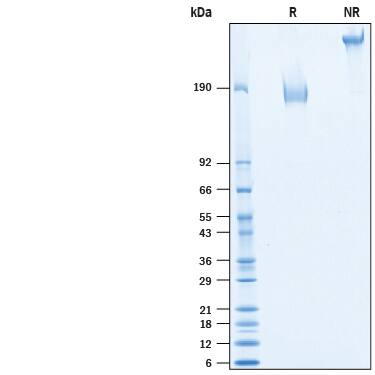Recombinant Human MUC-1 Fc Chimera Avi-tag Protein, CF
R&D Systems, part of Bio-Techne | Catalog # AVI10332
Biotinylated

Key Product Details
Learn more about Avi-tag Biotinylated Proteins
Source
HEK293
Accession #
Structure / Form
Disulfide-linked homodimer, biotinylated via Avi-tag
Conjugate
Biotin
Applications
Bioactivity
Product Specifications
Source
Human embryonic kidney cell, HEK293-derived human MUC-1 protein
| Human MUC-1 (Ser24-Ser380) Accession # P15941.3 |
IEGRMD | Human IgG1 (Pro100-Lys330) |
Avi-tag |
| N-terminus | C-terminus | ||
Purity
>95%, by SDS-PAGE visualized with Silver Staining and quantitative densitometry by Coomassie® Blue Staining.
Endotoxin Level
<0.10 EU per 1 μg of the protein by the LAL method.
Predicted Molecular Mass
62 kDa
SDS-PAGE
168-195 kDa, under reducing conditions
Activity
Measured by its binding ability in a functional ELISA.
When Biotinylated Recombinant Human MUC-1 Fc Chimera Avi-tag (Catalog # AVI10332) is immobilized at 1 µg/mL (100 µL/well), Recombinant Human Siglec-9 Fc Chimera (Catalog # 1139-SL) binds with an ED50 of 0.25-2 µg/mL.
When Biotinylated Recombinant Human MUC-1 Fc Chimera Avi-tag (Catalog # AVI10332) is immobilized at 1 µg/mL (100 µL/well), Recombinant Human Siglec-9 Fc Chimera (Catalog # 1139-SL) binds with an ED50 of 0.25-2 µg/mL.
Scientific Data Images for Recombinant Human MUC-1 Fc Chimera Avi-tag Protein, CF
Biotinylated Recombinant MUC-1 Fc Chimera Avi-tag Protein Binding Activity.
When Biotinylated Recombinant Human MUC-1 Fc Chimera Avi-tag (Catalog # AVI10332) is immobilized at 1 µg/mL (100 µL/well), Recombinant Human Siglec-9 Fc Chimera (1139-SL) binds with an ED50 of 0.25-2 µg/mL.Biotinylated Recombinant Human MUC-1 Fc Chimera Avi-tag Protein SDS-PAGE.
2 μg/lane of Biotinylated Recombinant Human MUC-1 Fc Chimera Avi-tag (Catalog # AVI10332) was resolved with SDS-PAGE under reducing (R) and non-reducing (NR) conditions and visualized by Coomassie® Blue staining, showing bands at 168-195 kDa and 320-380 kDa, respectively.Formulation, Preparation and Storage
AVI10332
| Formulation | Supplied as a 0.2 μm filtered solution in PBS with Trehalose. |
| Shipping | The product is shipped with dry ice or equivalent. Upon receipt, store it immediately at the temperature recommended below. |
| Stability & Storage | Use a manual defrost freezer and avoid repeated freeze-thaw cycles.
|
Background: MUC-1
References
- Rughetti, A. et al. (2005) J. Immunol. 174:7764.
- Engelstaedter, V. et al. (2012) BMC Cancer 12:600.
- Taylor-Papadimitriou, J. et al. (1999) Biochim. Biophys. Acta 1455:301.
- Geng, Y. et al. (2012) Front Oncol. 2:76.
- Tanida, S. et al. (2013) J Biol Chem. 288:31842.
- Beatson, R. et al. (2016) Nat Immunol. 17:1273.
- Piyush, T. et al. (2017) Cell Death Differ. 24:1937.
Long Name
Mucin 1, Cell Surface-associated
Alternate Names
CD227, Episialin, H23AG, KL-6, Mucin-1, PEM, PEMT
Entrez Gene IDs
4582 (Human)
Gene Symbol
MUC1
UniProt
Additional MUC-1 Products
Product Documents for Recombinant Human MUC-1 Fc Chimera Avi-tag Protein, CF
Product Specific Notices for Recombinant Human MUC-1 Fc Chimera Avi-tag Protein, CF
For research use only
